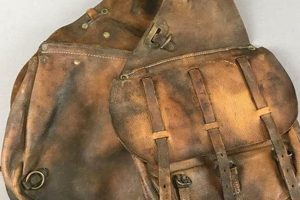Objects of leather craftsmanship produced by Coach during the final decade of the 20th century, these items represent a specific period in the brand’s history. These handbags, wallets, and accessories are now sought after by collectors and fashion enthusiasts for their distinctive designs and enduring quality.
The appeal lies in several factors: the association with a particular era, the relative durability of the materials used, and the accessible luxury they represent. Acquiring one of these items allows individuals to connect with a specific aesthetic and possess a piece of fashion history that often appreciates in value over time. This popularity underscores a growing interest in sustainable fashion and the rediscovery of timeless designs.
The resurgence of interest prompts exploration into identifying authentic models, understanding their construction, and appreciating the design elements that define this iconic period of Coach’s production. Subsequent discussion will delve into the characteristics, care, and current market value of these pieces.
Guidance on Acquiring Examples of Late 20th-Century Coach Leather Goods
The following provides essential advice for individuals considering the acquisition of Coach leather goods produced during the 1990s. Due diligence is paramount in ensuring authenticity and value.
Tip 1: Authenticate the Creed. The presence and accurate stamping of the creed, located inside the bag, is a crucial indicator. Research verifiable creed formats and fonts associated with this era of production.
Tip 2: Examine Stitching Quality. Coach maintained high standards of craftsmanship. Consistent, even stitching is characteristic of authentic pieces. Irregular or loose stitching should raise concerns.
Tip 3: Assess Hardware Composition. Hardware, including buckles, zippers, and clasps, should be solid brass or high-quality metal with a substantial feel. Check for consistent branding and functionality.
Tip 4: Evaluate Leather Condition. While natural aging is expected, significant damage, excessive cracking, or evidence of poor storage can negatively impact value. Consider professional cleaning and conditioning.
Tip 5: Verify Style Number. Every Coach bag has a style number, typically found within the creed. Cross-reference this number with online resources and vintage Coach catalogs to confirm authenticity and production dates.
Tip 6: Inspect Lining Fabric. Interior linings should be intact and composed of durable materials appropriate for the bag’s style. Tears, stains, or improper fabric choices are potential red flags.
Tip 7: Beware of Overly Aggressive Pricing. Prices that seem significantly lower than comparable items should be approached with caution. Investigate thoroughly before committing to a purchase.
These guidelines offer a starting point for informed decision-making. Thorough research and careful examination of each item are essential for successful acquisition.
The following section will address the care and maintenance of these vintage items, ensuring their longevity and continued value.
1. Timeless designs
The enduring appeal of Coach leather goods from the 1990s is deeply rooted in their designs, which have transcended fleeting trends to maintain relevance in contemporary fashion. These designs represent a specific aesthetic that continues to resonate with consumers seeking quality and understated elegance.
- Simplicity and Functionality
The designs prioritize clean lines and practical functionality, avoiding excessive ornamentation. This approach ensures the bags remain versatile and adaptable to various wardrobes and occasions. A prime example is the Coach City Bag, characterized by its minimalist silhouette and unembellished leather, making it suitable for both professional and casual settings. The deliberate absence of superfluous details contributes to its sustained appeal.
- Quality Materials and Craftsmanship
The emphasis on durable, high-quality leather and meticulous construction contributes significantly to the timeless nature of these bags. Superior materials ensure longevity, while careful craftsmanship results in pieces that age gracefully. A well-maintained Coach Willis bag, for instance, can retain its structural integrity and aesthetic appeal for decades, demonstrating the enduring value of quality materials and workmanship.
- Adaptability and Reinterpretation
The classic designs of these bags provide a versatile foundation for contemporary interpretation. Fashion designers and stylists often draw inspiration from these vintage styles, incorporating elements into modern collections. The simple shape of a Coach Dinky bag, for example, allows it to be easily updated with different hardware or straps, maintaining its relevance in evolving fashion trends. This adaptability ensures continued interest in and demand for these vintage pieces.
- Understated Luxury and Accessibility
These designs epitomize understated luxury, offering a sense of elegance and quality without ostentation. The accessible price point, relative to other luxury brands, further contributes to their widespread appeal. Owning a vintage Coach Courier bag, for example, provides a tangible connection to a period of classic American design, offering a sense of history and sophistication that remains desirable in today’s market.
The enduring success of Coach leather goods from the 1990s lies in their ability to balance classic design principles with practical functionality and accessible luxury. These factors ensure that these vintage pieces continue to be sought after by collectors and fashion enthusiasts alike, representing a lasting investment in both style and quality.
2. Leather quality
The leather used in Coach bags manufactured during the 1990s is a defining characteristic contributing significantly to their enduring value and appeal. Its specific qualities, treatment, and aging properties distinguish these items from more contemporary products.
- Full-Grain Leather Selection
Coach utilized full-grain leather, the highest quality available, for a substantial portion of its production during this period. This material, derived from the uppermost layer of the hide, retains the natural grain and inherent markings. Its robustness allows it to withstand considerable wear while developing a desirable patina over time. This inherent durability contributes significantly to the longevity of these accessories. For example, a well-maintained Coach Dinky bag from this era, crafted from full-grain leather, will display a supple texture and rich color depth indicative of the material’s superior quality.
- Tanning Processes
The tanning processes employed, often vegetable tanning or a combination of vegetable and chrome tanning, yielded leather that was both durable and pliable. Vegetable tanning, an older and more environmentally conscious method, relies on natural tannins found in plant matter. This results in leather with a distinct character and increased sensitivity to environmental factors. The resultant material is prone to developing a unique patina with use, enhancing its aesthetic value over time. Items that feature a combination of vegetable and chrome tanning techniques strike a balance between durability, suppleness, and color retention, often seen in models such as the Coach City Bag.
- Thickness and Weight
The leather used in these vintage bags is notably thicker and heavier compared to that found in many contemporary Coach products. This heavier weight provides structural integrity and contributes to the overall sense of quality. The increased thickness also offers greater resistance to abrasion and wear, extending the lifespan of the item. This attribute is particularly evident when comparing vintage Coach briefcases with their modern counterparts; the older models typically exhibit a more substantial feel due to the heavier leather construction.
- Aging Characteristics and Patina
One of the most desirable aspects of vintage Coach bags from the 1990s is the patina that develops over time. This patina, a soft sheen and deepening of color, is a natural consequence of the leather’s interaction with environmental elements and oils from handling. It enhances the visual appeal of the bag and signifies its authenticity and history. Collectors often seek out pieces that exhibit a well-developed patina, viewing it as a testament to the bag’s quality and its journey through time. In contrast, lower-quality leathers may crack, peel, or fade with age, lacking the capacity to develop a desirable patina.
The superior leather quality evident in Coach bags from the 1990s is a primary factor driving their collectibility and enduring appeal. The use of full-grain leather, traditional tanning methods, and substantial thickness contribute to their durability and the development of a rich patina over time, distinguishing them as objects of enduring value and craftsmanship.
3. Brass hardware
The incorporation of solid brass hardware is a hallmark of Coach bags manufactured during the 1990s, representing a commitment to quality and durability that distinguishes them from many contemporary offerings. This material choice influences the aesthetic, functionality, and longevity of these vintage accessories.
- Durability and Longevity
Solid brass is inherently resistant to corrosion and wear, ensuring that buckles, clasps, zippers, and other hardware components maintain their functionality and aesthetic appeal over extended periods. Unlike plated metals that can chip or tarnish, solid brass develops a natural patina with age, enhancing the vintage character of the bag. A well-maintained Coach City Bag from the 1990s, for instance, will exhibit brass hardware with a warm, aged tone that complements the leather’s patina, reflecting the bag’s history and quality construction.
- Aesthetic Contribution
The warm, golden tone of solid brass hardware provides a visual contrast to the leather, enhancing the overall aesthetic of the bag. This contrast is particularly effective with darker leather colors, such as black or British tan, where the brass hardware serves as a subtle yet distinctive accent. The deliberate choice of brass hardware underscores the brand’s commitment to understated elegance, contributing to the timeless appeal of these vintage pieces. The design choice provides a sense of luxury with its quality.
- Functional Reliability
The robust construction of solid brass hardware ensures reliable functionality. Buckles remain secure, zippers operate smoothly, and clasps maintain their grip, even after years of use. This reliability is essential for the bag’s practicality and contributes to its overall value. The high quality can be identified and differetiated to lower quality hardware.
- Authenticity Indicator
The presence of solid brass hardware can serve as an indicator of authenticity. Coach bags from the 1990s typically featured solid brass components, while counterfeit or lower-quality reproductions may utilize plated metals or alloys that lack the weight and durability of genuine brass. Careful examination of the hardware’s material composition and construction can assist in verifying the authenticity of a vintage Coach bag.
The use of solid brass hardware in Coach bags manufactured during the 1990s reflects a commitment to quality, durability, and aesthetic appeal. Its robust construction, warm tonal quality, functional reliability, and potential as an authenticity indicator contribute significantly to the value and desirability of these vintage accessories. These bags are more than just accessories, with many historical facts.
4. Creed authenticity
The stamped creed, a leather patch typically located inside Coach bags, serves as a crucial element in verifying the authenticity of pieces manufactured during the 1990s. Its presence, content, and construction provide valuable insights into the bag’s origin and legitimacy.
- Creed Content and Structure
The creed typically includes a statement of quality, a registration number, and the location of manufacture. The specific wording and layout of these elements varied over time, and knowledge of these variations is essential for authentication. For example, a creed stating “This is a Coach Bag” followed by a unique registration number indicates a genuine item, while misspellings or inconsistencies in the wording raise concerns about authenticity.
- Registration Number Significance
The registration number found within the creed provides information about the bag’s style, production date, and place of manufacture. Deciphering this number requires familiarity with Coach’s coding system during the 1990s. Resources such as vintage Coach catalogs and online databases can aid in this process. An authentic registration number should correspond to a known Coach style and production period, while a missing or unidentifiable number suggests a counterfeit.
- Creed Stamp Quality and Placement
The quality of the creed stamp itself is a key indicator. Legitimate Coach bags from the 1990s feature a clear, crisp stamp with consistent font and spacing. The stamp should be evenly impressed into the leather, without smudging or distortion. The placement of the creed patch within the bag is also consistent for specific styles and production periods. Deviation from these norms may indicate a counterfeit.
- Leather Patch Characteristics
The leather used for the creed patch should be consistent with the quality of the bag’s overall construction. It should be supple, durable, and properly finished. The stitching attaching the creed patch to the bag should be neat, even, and secure. Inferior leather or sloppy stitching are red flags that suggest the bag is not genuine.
In summary, careful scrutiny of the creed its content, registration number, stamp quality, and leather patch characteristics is essential for establishing the authenticity of vintage Coach bags from the 1990s. Discrepancies in any of these areas warrant further investigation and may indicate a counterfeit item.
5. Style numbers
Style numbers constitute a critical component in authenticating and identifying Coach bags produced during the 1990s. These alphanumeric codes, typically found within the creed, provide specific details regarding the bag’s design, materials, and production period. Their presence and accuracy are essential for distinguishing genuine vintage items from counterfeit versions. For example, a Coach Willis bag manufactured in 1995 will possess a distinct style number reflecting its specific design and features. Without a verifiable style number, the authenticity of the bag becomes questionable.
The practical significance of understanding style numbers extends beyond mere authentication. Collectors and enthusiasts utilize this information to research specific models, assess their rarity, and determine their market value. By cross-referencing style numbers with vintage Coach catalogs and online resources, individuals can gain insights into the bag’s original retail price, available color variations, and any unique design elements. This knowledge empowers informed purchasing decisions and allows for a deeper appreciation of the craftsmanship and historical context of each piece. An incorrect or mismatched style number serves as an immediate indication of potential fraud or alteration.
The challenge lies in accessing and interpreting reliable style number information, as official Coach archives from this period are not always readily available to the public. However, dedicated online communities and vintage Coach experts often possess valuable resources and expertise in deciphering these codes. Successfully navigating this information landscape is crucial for both novice and experienced collectors seeking to acquire authentic and valuable Coach bags from the 1990s. Accurate identification through style numbers reinforces the bags provenance and contributes to its sustained appeal in the vintage market.
6. USA Made
The “USA Made” designation holds significant weight in the context of Coach bags produced during the 1990s. It represents a specific era in the brand’s history when manufacturing was primarily based within the United States, influencing both the quality and collectibility of these vintage items.
- Quality Control and Craftsmanship
Manufacturing within the United States during this period allowed Coach to maintain stringent quality control standards. Skilled American labor and established production processes contributed to the superior craftsmanship evident in these bags. “USA Made” often signifies a higher level of attention to detail, resulting in durable and well-constructed products. Examples include consistent stitching, precisely aligned hardware, and careful leather selection, all indicative of meticulous American manufacturing practices.
- Material Sourcing and Regulations
Producing bags in the USA often meant sourcing materials from domestic suppliers, which were subject to specific regulations and standards. This could impact the type of leather used, the composition of hardware, and the dyes employed in the manufacturing process. These regulatory factors contributed to the distinct characteristics of “USA Made” Coach bags from the 1990s. For example, the leather used was often thicker and more durable than that found in later, internationally produced bags, due to differences in tanning regulations and material availability.
- Historical and Brand Significance
The “USA Made” label carries historical significance, reflecting a time when Coach was primarily an American company with a strong commitment to domestic manufacturing. This association enhances the brand’s heritage and contributes to the desirability of these vintage bags among collectors. Owning a “USA Made” Coach bag from the 1990s represents possessing a tangible piece of American manufacturing history and a connection to the brand’s roots.
- Increased Collectibility and Value
Due to factors such as superior quality, limited production runs, and historical significance, “USA Made” Coach bags from the 1990s often command higher prices in the vintage market compared to those manufactured later in other countries. The “USA Made” designation serves as a marker of authenticity and quality, increasing the bag’s appeal to collectors seeking rare and well-preserved examples of Coach’s American heritage.
The convergence of quality control, material sourcing, historical significance, and market value underscores the importance of the “USA Made” designation in understanding and appreciating vintage Coach bags from the 1990s. This label represents a specific chapter in the brand’s history, characterized by a commitment to American manufacturing and craftsmanship that continues to resonate with collectors and enthusiasts.
Frequently Asked Questions
The following addresses common inquiries regarding Coach leather items produced during the 1990s. The aim is to provide clarity and dispel misconceptions concerning authenticity, value, and care.
Question 1: How does one differentiate between authentic vintage Coach bags from the 1990s and contemporary replicas?
Authenticity verification relies on meticulous examination. Key indicators include the presence and accuracy of the creed, the quality of the leather and stitching, the use of solid brass hardware, and the verification of the style number against known Coach records from that era.
Question 2: What factors influence the market value of a bag from this period?
Several elements contribute to value: condition (minimal wear and tear), rarity (limited edition models), desirability of the style, presence of original accessories (hangtag), and provenance (documented history of ownership).
Question 3: Is professional cleaning recommended for leather from this era?
Professional cleaning is advisable for significant soiling or damage. However, it is crucial to select a cleaner specializing in vintage leather goods to avoid irreversible damage or alteration of the material’s original characteristics.
Question 4: How should these leather items be properly stored to prevent deterioration?
Optimal storage involves stuffing the bag with acid-free paper to maintain its shape, storing it in a dust bag to protect it from light and dust, and keeping it in a cool, dry environment away from direct sunlight or extreme temperatures.
Question 5: Are there specific leather conditioners recommended for vintage Coach leather?
Avoid products containing silicone or lanolin, as these can damage the leather over time. Opt for pH-neutral conditioners specifically designed for vegetable-tanned or full-grain leather, applying sparingly and following product instructions carefully.
Question 6: To what extent does the “Made in USA” designation affect the value of these bags?
The “Made in USA” designation typically enhances the value and collectibility of bags from this period, reflecting a time when Coach maintained high standards of domestic manufacturing and quality control. Items bearing this mark are often perceived as being of superior construction and material quality.
Understanding these factors is crucial for both collectors and individuals seeking to acquire and preserve these artifacts of fashion history.
Subsequent discussion will explore the ongoing influence of the designs on contemporary fashion.
Conclusion
This exploration has illuminated the defining characteristics and enduring appeal of vintage Coach bags 1990s. From the superior quality of materials and construction to the historical significance of the “USA Made” designation, these factors collectively contribute to their desirability among collectors and fashion enthusiasts. Understanding style numbers, creed authenticity, and the nuances of leather aging are critical in appreciating these artifacts of a specific era.
The ongoing interest in vintage Coach bags 1990s underscores a broader appreciation for sustainable fashion and enduring design. These pieces serve as tangible reminders of a commitment to quality and craftsmanship that transcends fleeting trends, inviting continued study and preservation.







